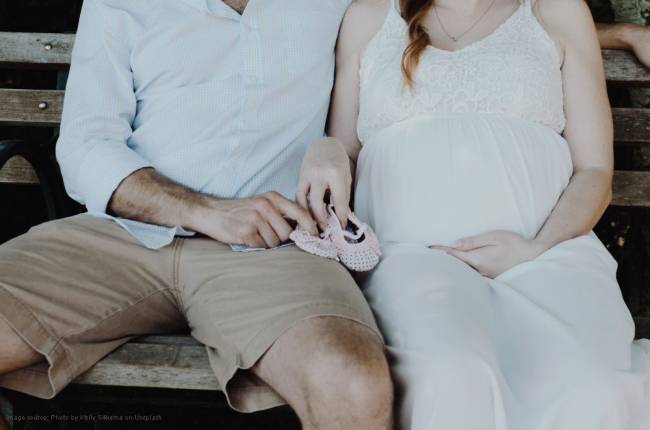DAD.info has teamed up with Emma’s Diary, the UK’s leading pregnancy programme, to bring expecting dads some essential tips to prepare for the big day…

Childbirth these days is very much a hands-on experience for dads. Gone are the days where expectant fathers were expected to sit in the visitor’s room waiting for the announcement they were now a dad.
Of course, not all dads (or their partners) want to be totally hands-on during birth, and no family should do something they are uncomfortable with. But with a little preparation (forewarned is forearmed), dads can get so much more out of the whole experience and really play a major part in their child’s birth.
Reading childbirth books such as The Expectant Dads Handbook is a good idea, and the UK’s leading pregnancy programme, Emma’s Diary, also offers credible pregnancy and post-natal advice to expectant mothers and fathers, working in association with the Royal College of General Practitioners (RCGP) and healthcare experts.
We’ve teamed up with them to bring you the essential facts you need to know…
1. Plan the travel arrangements!
If you are giving birth in a hospital or birth centre, make sure you know your way to the maternity unit and how long it will take you. If you are having your baby at home, make sure you make your phone call to call out the midwife so she also has time to be able to travel to you.
Take into account how heavy traffic might be at different times of the day, as making the journey during the rush hour or school run times could take twice as long.
2. Is she in labour or not?
In the third trimester many women experience practice contractions known as Braxton Hicks; unlike labour contractions, these don’t build up and won’t result in a baby being born! Signs that it is labour rather than Braxton Hicks could include her waters breaking (which could be a trickle or a gush of fluid). Labour usually starts within 12 hours of this happening, but be warned, unlike the movies, in the vast majority of cases, contractions will start a while before the waters break. Persistent lower back ache is another sign of labour starting, which can also be accompanied by a cramp-like, premenstrual feeling.
3. Time the contractions
Contractions usually occur at regular and increasingly shorter intervals and get longer and stronger. Time her contractions from the beginning of one contraction to the beginning of the next. When they are coming around every 5-6 minutes and lasting about 45 to 60 seconds you should phone the number given by her midwife (usually on the front page or two of her maternity notes), as it is probably getting close to the time for travelling to the hospital or birth centre, or for your midwife coming out to you for a home birth.
4. Timing is key
If you take your partner to maternity unit too early and she has only just started to dilate, then unless you live in a remote area, or there’s a chance of snowfall, it’s more than likely you’ll both be sent home. So if the contractions start quite gently try to take her mind off them. Watch a movie, run her a warm bath, get something to eat or, better still, try to grab a few hours rest. It’s frustrating and makes the whole labour process seem interminably long if you are hanging around at the hospital for too many hours in early labour stage.
5. Know what’s coming
Babies can be born as quickly as they are in the movies but is uncommon. For a lot of women, and especially first time mums, labour lasts between 12 and 24 hours. Early labour can take hours or even days, with the active labour stage possibly taking around five or six hours. The second phase, as your baby is being born and your partner making all this amazing effort, can bring on mixed emotions for you.
Also, be prepared for your partner to get a little grumpy with you at different points, she may even swear and blame you for putting her through it! Your important job is to just ‘be there’ for her. Help her with her breathing if she wants you to. Rub her back or feet if she wants you to. Make sure she drinks and keeps hydrated. In fact, just do anything she wants you to!
6. Baby arrives
Although you will probably be standing there in open-mouthed awe and wonder, you do have other things to think about right now. Had you planned to take photos? Film the arrival? Did you want to cut the cord? What about your other choices on your birth plan, like delayed cord clamping, whether you want vitamin K administered to the baby and if so, how? You need to speak up and advocate for those wishes you have discussed in advance.
7. Then the placenta…
The birth of your baby is followed by the birth of the placenta. This can take anything from a few minutes, to up to an hour. Keeping mum feeling warm, calm and cuddling her baby is all important, as this will help with birthing the placenta – stay close to mum and support her to stay comfortable. Be ready for cuddles with your baby too, in case she wants to change position or needs a break.
8. Afterwards
If your baby was born at hospital, depending on the time of day or night, there might be limited options for eating and drinking. Midwives are usually great at sorting out some tea and toast, but anything else she might want to have straight away, try and have to hand.
If you don’t want bedside photography following the birth of your baby, make sure to mention this to your midwife at the hospital.
9. Support her
Birth causes a lot of physical and hormonal changes in a woman, and it’s important her body has time to recover, and she doesn’t try to do too much too soon. Cuddling and getting to know your new baby is her most important work in these first few days! Help her not only with practical tasks like changing nappies, but also in practical ways around the home, and by making sure visitors don’t outstay their welcome.
Emma’s Diary offers credible pregnancy and early post natal advice in collaboration with The Royal College of General Practioners and a network of health care professionals.
For more information and advice, visit Emma’s Diary.








